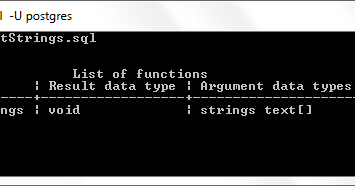To search and replace all occurrences of a string with a new one, you use the REPLACE () function. However, the C names of all functions must be different, so you must give overloaded C functions different C names (for example, use the argument types as part of the C names). I will use flags i and g for case-insensitive and global matching, respectively. How to replace postgresql function body?

Let’s see some examples to understand how the REGEXP_REPLACE() function works. Functions allow database reuse as other applications can interact directly with your stored procedures instead of a middle-tier or duplicating code. A while back, I wrote Useful String Function – REPLACE in MySQL with examples. This website uses cookies to improve your experience while you navigate through the website.
Out of these cookies, the cookies that are categorized as necessary are stored on your browser as they are essential for the working of basic functionalities of the website. For a scalar function the rows is not applicable so we leave that out for this simple example. The cost is relative to other functions and defaults to 1unless you change it. Here is the list of operator and string functions below.
All the examples I have found used the functions in a select query such as CREATE OR REPLACE FUNCTION. The following table details the important string functions −. What is the description and syntax of the REPLACE() function? How do we use the REPLACE function in our SQL?
Summary: in this tutorial, you will learn how to use the SQL REPLACE function to search and replace all occurrences of a substring with another substring in a given string. We’ll also use the CHR() function and string concatenation. Introduction to the SQL REPLACE function. Sometimes, you want to search and replace a substring with a new one in a column e. The function returns VARCHARif the first argument is not a LOB and returns CLOB if the first argument is a LOB. REPLACE lets you substitute one string for another as well as to remove character strings.
TRANSLATE provides single-character, one-to-one substitution. PostgreSQL Has Three Regular Expression Flavors. It’s useful for getting rid of null values. Our function takes two arguments, an employee and a car i both being integers.
Well, you will surprising to know that in Postgresql is possible and is quite simple to add this function. Postgres provides the string replace function , but at a time you can replace string for a particular column. Recently, I got the requirement like replace same string value in multiple columns.
Let us check these two functions and how to use them as an alternative method to replace string values. The Hive translate function translates the input string by replacing the characters present in the from string with the corresponding characters in the to string. If any of the parameters to this UDF are NULL. In MySQL, the REGEXP_REPLACE() function replaces occurrences of the substring within a string that matches the given regular expression pattern.
The whole string is returned along with the replacements. If there’s no match (i.e. the input string doesn’t contain the substring), the the whole string is returned unchanged. There is another approach to doing this, and that is to use the ANSI Standard RETURNS TABLE construct. If you come from a SQL Server or IBM DBbackgroun the RETURNS TABLE construct is probably most familiar, but still how.
Why is the default behavior different? I know that with regexp_ replace one can use the g option to replace all occurrences of a substring in a string. The second parameter is an arrays containing all characters, that should be replaced.
The third parameter is an array, too.
Brak komentarzy:
Prześlij komentarz
Uwaga: tylko uczestnik tego bloga może przesyłać komentarze.